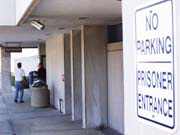Twenty years ago, town officials got their first clue as to how inappropriate the new Town Hall was for some activities.
Women, suing the town over alleged discrimination in hiring, noted in their arguments that the police station (which is located in Town Hall) did not even has separate bathrooms for female personnel in the department.
While the court case eventually led to the intervention of the U.S Justice Department and the signing of a consent agreement on hiring women and minorities, the facilities remained largely inadequate for the needs of the police. An evaluation by the state Department of Corrections cited numerous minor problems and several glaring problems with facilities. The building, which had been designed for municipal uses, did not meet basic standards set by the state, and in some cases, posed a serious risk of injury to innocent people.
“When I first became a councilman under the former chief of police, we were cited by the state for a number of different things,” said Mayor Dennis Elwell, in commenting on the most recent state report that showed the police station had made all the improvements required.
While the department was cited for lack of a separate woman’s restroom to allow female officers to shower and change, more serious was the fact that the facility lacked a separate entrance for prisoners, and that sometimes prisoners were escorted into the station through the same hallway then being used by the general public.
“There was a danger in having prisoners brought into the station when you had people in there looking for accident reports and seeking other information,” Elwell said. “At any moment a prisoner might wrestle free of a police officer and use a citizen for a hostage.”
Former Mayor Anthony Just tried to meet the state requirements by moving Town Hall. By purchasing a building being vacated by Square D Corporation, the town would have had enough room to comply with the state mandates. The council at the time voted the move down, and so the problems lingered.
Cost estimates done during the early 1990s were prohibitive, especially at a time when tax appeals were putting upward pressure on the municipal budget.
In upgrading the facility over the last few years, the town used creative means to solve some of the problems. Rather than rebuilding the entire station area in order to install a completely different means of access, town and police official rearranged offices, installing a window near the front of the police portion of the building so that residents didn’t have to enter the police area to obtain records. By moving the police chief’s office and other facilities, the police department could use the same space and still meet the state guidelines. In one case, providing a separate entrance for prisoners simply required contractors to cut a hole in the wall to the hall and installing a door.
“We started to address many of these problems when I first became mayor,” Elwell said. “We understood that it was going to cost us some money do meet the state requirements.”
State officials from the Department of Corrections visited the police station on May 1 of this year, and on a list of about 100 items, the facility complied in every area. The report noted that Secaucus also has six cells, three designated for male prisoners and three for female. During the year that ended last April, Secaucus housed a total of 384 prisoners, none of which were held over 24 hours. There were no escapes or attempted escapes, and the facility saw no suicides or attempted suicides.
“We’re very proud of what we accomplished,” Elwell said.
